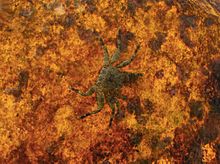
Cheloniidae is a family of typically large marine turtles that are characterised by their common traits such as, having a flat streamlined wide and rounded shell and almost paddle-like flippers for their forelimbs. They are the only sea turtles to have stronger front limbs than back limbs. The six species that make up this family are: the green sea turtle, loggerhead sea turtle, olive ridley sea turtle, hawksbill sea turtle, flatback sea turtle and the Kemp's ridley sea turtle.

The olive ridley sea turtle, also known commonly as the Pacific ridley sea turtle, is a species of turtle in the family Cheloniidae. The species is the second-smallest and most abundant of all sea turtles found in the world. L. olivacea is found in warm and tropical waters, primarily in the Pacific and Indian Oceans, but also in the warm waters of the Atlantic Ocean.
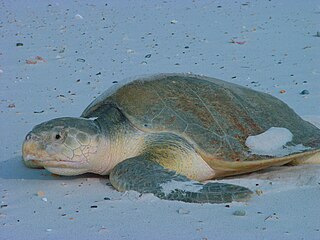
Kemp's ridley sea turtle, also called the Atlantic ridley sea turtle, is the rarest species of sea turtle and is the world's most endangered species of sea turtle. It is one of two living species in the genus Lepidochelys.

The Australian flatback sea turtle is a species of sea turtle in the family Cheloniidae. The species is endemic to the sandy beaches and shallow coastal waters of the Australian continental shelf. This turtle gets its common name from the fact that its shell has a flattened or lower dome than the other sea turtles. It can be olive green to grey with a cream underside. It averages from 76 to 96 cm in carapace length and can weigh from 70 to 90 kg. The hatchlings, when emerging from nests, are larger than other sea turtle hatchlings when they hatch.

Ghost nets are fishing nets that have been abandoned, lost or otherwise discarded in the ocean. These nets, often nearly invisible in the dim light, can be left tangled on a rocky reef or drifting in the open sea. They can entangle fish, dolphins, sea turtles, sharks, dugongs, crocodiles, seabirds, crabs, and other creatures, including the occasional human diver. Acting as designed, the nets restrict movement, causing starvation, laceration and infection, and suffocation in those that need to return to the surface to breathe. It's estimated that around 48,000 tons of ghost nets are generated each year, and these may linger in the oceans for a considerable time before breaking-up.

Ridley sea turtles are a genus (Lepidochelys) of sea turtle comprising two species: Kemp's ridley sea turtle and the olive ridley sea turtle.
Gahirmatha Beach is a beach in Kendrapara district of the Indian state of Odisha. The beach separates the Bhitarkanika Mangroves from the Bay of Bengal and is the world's most important nesting beach for olive ridley sea turtles. The beach is part of Gahirmatha Marine Wildlife Sanctuary, which also includes the adjacent portion of the Bay of Bengal.

Fernando de Noronha Marine National Park is a national park in the state of Pernambuco, Brazil.

The red rock crab, Guinusia chabrus, is a marine large-eyed crab of the family Plagusiidae. It is found in the southern Indian and southern Pacific Oceans, including South Africa, Australia, New Zealand, and Chile.

The Grapsoidea are a superfamily of crabs; they are well known and contain many taxa which are terrestrial (land-living), semiterrestrial, or limnic. Another well-known member with a more conventional lifestyle is the Chinese mitten crab, Eriocheir sinensis.
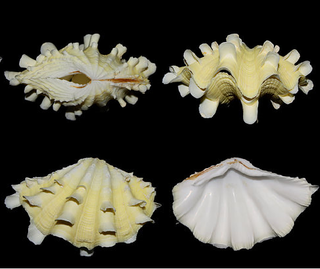
Tridacna squamosa, known commonly as the fluted giant clam and scaly clam, is a species of bivalve in the family Cardiidae.
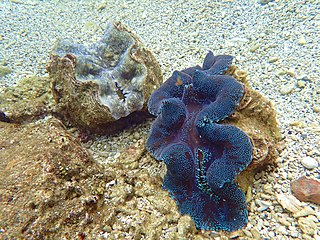
Tridacninae, common name, the giant clams, is a taxonomic subfamily of very large saltwater clams, marine bivalve molluscs in the family Cardiidae, the cockles.

Arvoredo Marine Biological Reserve is a Biological reserve off the coast of the Santa Catarina state, Brazil.

Taka Bonerate National Park is a marine park which includes the Takabonerate atoll islands, located in the Flores Sea, south of Sulawesi island of Indonesia.
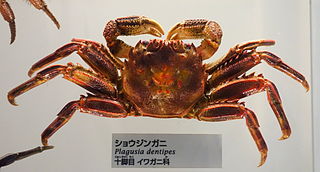
Plagusia is a genus of crabs in the family Plagusiidae, containing the following species:

The gulf ghost crab, Hoplocypode occidentalis, is a species of ghost crabs native to the Pacific coast of the Americas, from the Gulf of California to Colombia. It is the only species in the genus Hoplocypode. Gulf ghost crabs are medium-sized, reaching a maximum overall body diameter of 6 in (15 cm). They are one of only two ghost crab species found in the eastern Pacific. However, gulf ghost crabs can easily be distinguished from painted ghost crabs by the absence of "horns" on their eyes.

Platylepas hexastylos is a species of barnacle in the family Platylepadidae. It is native to the Indo-Pacific Ocean where it lives as a symbiont of such large marine creatures as the dugong, the green sea turtle, the olive ridley sea turtle, or the loggerhead sea turtle.
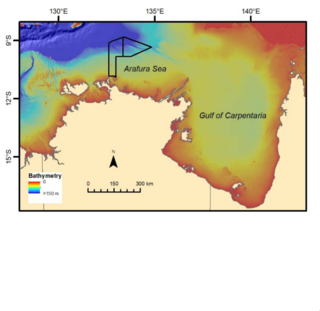
The Arafura Marine Park, about 250 km (160 mi) north-east of Darwin, is Australia's most northern marine park, and is part of the North Network of Australian Marine Parks. The Aboriginal clans of Mandilarri-Ildugij, the Mangalara, the Murran, the Gadura-Minaga and the Ngaynjaharr whose sea country this is, share some of the responsibilities for the park.
The Dolphin Nature Conservation Society (DNCS) is a registered voluntary environmental non-profit and non-governmental organization (NGO) located in Visakhapatnam, Andhra Pradesh, India. It is committed to the causes of nature conservation, environmental protection, research, education, and awareness. The society was founded on March 5, 2001, by Dr. Mantha Rama Murty and Dr. Mangathayi, who had previously launched several nature conservation programs in Andhra Pradesh, particularly in Visakhapatnam. The organization's activities are intended to instill a love for nature and conservation among people, especially among the younger generation. Notable research, documentation, conservation, and awareness campaigns of the society have involved Olive-Ridley Sea Turtles, intertidal rocky shore fauna and flora of the Visakhapatnam coast, and butterflies of the Eastern Ghats. The society's flagship project is the development and maintenance of the Biodiversity Park in Visakhapatnam.

